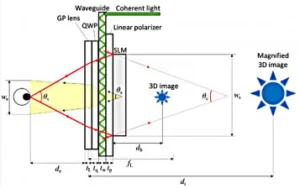A team of researchers headed by Jonghyun Kim along with colleagues at Nvidia Corporation (Santa Clara, CA) and collaborators at Stanford University (Palo Alto, CA) are developing a holographic display in a glasses-like form factor.

A recent article by the team on this topic was entitled “Holographic Glasses for Virtual Reality.” It was published in the Special Interest Group on Computer Graphics and Interactive Techniques section of the Conference Proceedings of SIGGRAPH ’22, August 7-11, 2022, Vancouver, BC, Canada. A copy of the article is available on-line can be downloaded here.
Called Holographic Glasses, the device includes a coherent light source that is coupled into a pupil replicating waveguide that is located directly in front of the user’s eye. The light source is used to provide illumination for a phase only spatial light modulator (SLM). The SLM is mounted directly on the waveguide without an air gap to minimize the thickness of the display. The SLM produces a small image behind the device, which is magnified by a thin geometric phase (GP) lens. A GP lens, also known as a Pancharatnam-Berry phase lens, is a polarization dependent liquid crystal lens that works as a positive lens for a certain input beam polarization. In the glasses application, this type of lens has the relevant and desirable properties of being both thin and light weight.
A schematic diagram of the optical system used in the Holographic Glasses appears in the figure below.
Schematic diagram of the optical system used in the Holographic Glasses.
A detailed explanation of how the optics works to produce a holographic image is presented in the technical article. One interesting point to note is that the wearer’s pupil is used as a natural Fourier filter.
In the article, particular note is made of the fact that the design of the glasses optical system builds on recent ideas that use artificial intelligence techniques to improve the image quality and accelerate the computation of computer generated holograms. In their current research, the team used an algorithmic framework called Pupil-HOGD (High Order Gradient Descent) that considers both high diffraction orders and pupil size. More specifically, a novel pupil high order gradient descent algorithm is used to correct the phase calculation to correspond to the varying pupil size of the user.
Part of the claim that the Holographic Glasses have a “glasses-like” form factor derives from the fact that the “lenses” in the glasses have an optical stack thickness from the frontal surface to the spatial light modulator plane of just 2.5 mm.
Further performance and specification details of the Holographic Glasses derive from test and measurements made on benchtop and wearable prototypes. It was found that the binocular wearable prototype provided a diagonal field of view of 22.8 degrees, a 2.3 mm static and 8 mm dynamic eye box. In addition, the device supports 3D focus cues and weighs only 60 g excluding the driving board.
A video appended to the end of this article contains a presentation on the Holographic Glasses.
The holographic virtual reality glasses developed by the team are represented in their article as the first of its kind having a true glasses like form factor. -Arthur Berman
NVIDIA, Jonghyun Kim, http://j-kim.kr

